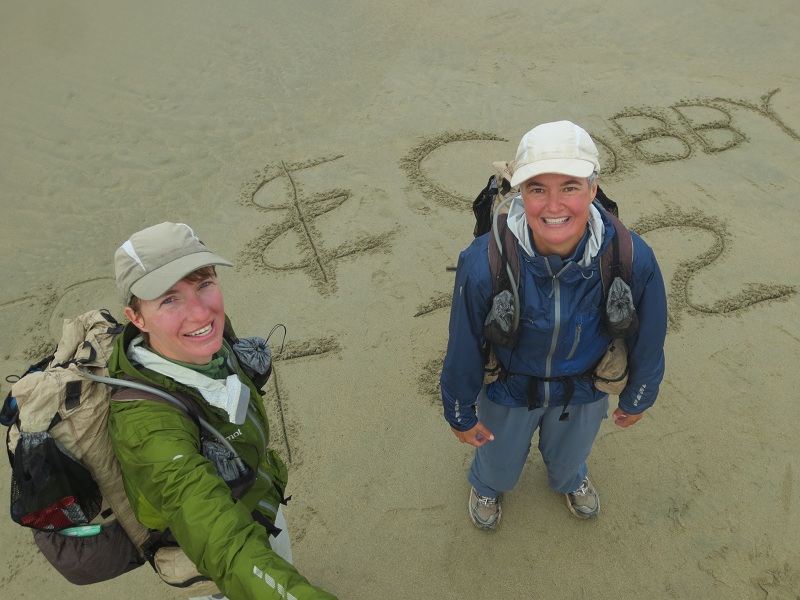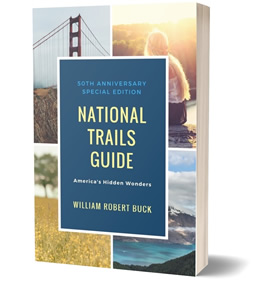The National Trails System is a world-class network of Congressionally-designated trails which span the United States. The Appalachian Trail (AT), Pacific Crest Trail (PCT) and Continental Divide Trail (CDT) together cover about 8,000 miles — people who complete all three of these long trails over a period of time are bestowed with the hiking community’s ‘Triple Crown.’
In addition to these well-loved national trails, there is a legendary east to west route called the American Discovery Trail (ADT). This is considered a “new breed of national trail — part city, part small town, part forest, part mountains, part desert — all in one trail” according to the American Discovery Trail Society. The nearly 7,000 mile route is designated for walking and other non-motorized uses, connecting five national scenic trails, 12 national historic trails, 34 national recreational trails, and many local and regional trails all the way from the coast of Delaware to Point Reyes in California. (To learn more about this trail, visit www.discoverytrail.org.)
Two thru-hikers — “Boston” and “Cubby” — have completed the entire American Discovery Trail. As they have previously achieved Triple Crown status, they now hold a rare claim — ‘Grand Slam!’ We interviewed them and are sharing it here with our National Trails Guide readers as part of our thru-hiker blog series. Enjoy!
How did your passion for hiking begin?
We had done multi-day backpacking trips in Grand Canyon National Park and Grand Tetons National Park. Then in 2005, a good friend of ours invited us to hike the Appalachian Trail. We both had known about the Appalachian Trail, and jumped at the chance to thru-hike it.
What are some of the motivations that drive you to do long distance hikes?
The one-word answer is challenge. A thru-hike starts with one fundamental challenge: Can we hike all the way from beginning to end? All the while, knowing that if we do not make it all of the way, we can’t just start up again later, right where we left off. A thru-hike is all or nothing. We know that from the very first step if we don’t complete all of the steps all the way to the last one, we will have to start all over again from the beginning. That is a strong and powerful challenge that can propel a thru-hiker through all kinds of adversity. It also makes the completion of a thru-hike all the more satisfying. It’s a big goal with a big personal reward.
There are other motivating factors too. There are the obvious draws of nature and wildlife, and sights yet unseen. There are new places to go and new people to meet. A long-distance multi-month hike also gives us the opportunity to experience life more simply. Life is distilled down to the basic needs of water, food, shelter, and happiness.
What National Trails have you completed?
The AT was our first long-distance multi-month hike. We started out with very little knowledge of long-distance hiking, but by the end we had both been bitten by the thru-hiking bug. We started looking for other long-distance trails to thru-hike. Along the way, we decided to hike to the summit of Mt. Kilimanjaro in 2007 before starting our next thru-hike. In 2008, we thru-hiked the Continental Divide Trail. In 2010, we finished the “Triple Crown” by thru-hiking the Pacific Crest Trail. In conjunction with our PCT hike, we also thru-hiked all of the John Muir Trail. Still having a strong desire for another long-distance hike, we thru-hiked the American Discovery Trail to complete hiking’s “Grand Slam”.
Would you recommend this to others?
We would most definitely recommend this to others! Go outside. Touch the real world. The real world is wildlife, mountains, streams, dirt, grass, rock, and trees. It still exists beyond the asphalt, air-conditioning, and internet.
What were some of the best outcomes for you from these experiences?
We always come away from one of these hikes with the desire to live life more simply. We have met the kindest and most generous people from all backgrounds and circumstances.
What are some of the solutions you came up with to everyday challenges? (For example, dealing with dirty/wet clothes, insects, weather, sleeping conditions, etc.)
It does go back to that saying, an ounce of prevention is worth a pound of cure. That being said, believing in the fact that it’s never as bad as you think it is, can get you through just about any tough situation. We try to start with good lightweight hiking gear to prevent these situations, but gear is not the answer to everything. Decision making is the key. As we always say, hope is not a plan. Making a decision early and following through can prevent many tough situations.
Were there any particularly challenging experiences you would like to share?
On the American Discovery Trail, we experienced record breaking heat in remote waterless areas. It forced us to hole-up in small spaces under boulders for hours during the peak of the day. We would be in there for up to 5 hours in 110-degree heat, waiting for the cloud-cover to roll in or the sun to go down to alleviate the 120-degree heat outside, so that we could continue on. It was a mental test to remain calm, stay put, and make solid decisions on when to continue, knowing that if we left too early, we could have disastrous results.
How often did you consult your maps/GPS devices and was that a reasonable process for you?
We continually referenced our map and GPS. The American Discovery Trail is a GPS route with GPS-waypoint derived directions. We used our GPS extensively. We also always kept ourselves “on the map”. This refers to always knowing where you are on your map. It doesn’t do much good to have a map of the area if you don’t know where you are on it.
Were there any particular types of technology (electronic, hardware/equipment, etc.) that were especially useful for you and would you recommend them to others?
The GPS is a very useful tool, but only if you know how to use it. It’s not only a good tool, but it can be a lot of fun too. We carried a cell phone. We liked the ability to have friends and family contact us if they had important information to pass along to us.
Do you have a favorite National Trail and is there another you’d like to complete?
We really liked the Continental Divide Trail for its grand scale. We also like the Pacific Crest Trail for its community of fellow hikers. We’re always looking at the possibilities for our next hike.
Any suggestions to improve the thru-hiker experience on National Trails?
There are all kinds of ways to enjoy a trail. You can be a day-hiker, a weekender, or a week-long hiker. Then you can step it up a notch and try to hike the whole trail in one continuous journey in one big thru-hike. Thru-hiking is somewhat of a sport, and as with all sports, it has evolved. A long hike used to involve heavy backpacks and heavy boots. It no longer has to be that way. Gear has changed. Tents started out with canvas, then changed over to sil-nylon, and now they are being made of cuben fiber. Most long-distance hikers wear trail runners, not boots. New lightweight gear is making it possible to carry much lighter loads, enabling people of all ages and abilities to go on long hikes. Carrying less weight also vastly increases the enjoyment of the hike.
If you really want to enjoy a hike, start hiking!
-Read more about the adventures of “Boston & Cubby” (Julie Obear and Barry King) — www.trailjournals.com.
“You may be a little cold some nights, on mountain tops above the timber-line, but you will see the stars, and by and by you can sleep enough in your town bed, or at least in your grave.”
–John Muir, 1898

